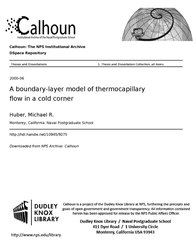File:A boundary-layer model of thermocapillary flow in a cold corner (IA aboundarylayermo109459275).pdf

Original file (1,275 × 1,650 pixels, file size: 4.16 MB, MIME type: application/pdf, 136 pages)
Captions
Captions
Summary[edit]
| A boundary-layer model of thermocapillary flow in a cold corner
( |
||
|---|---|---|
| Author |
Huber, Michael R. |
|
| Title |
A boundary-layer model of thermocapillary flow in a cold corner |
|
| Publisher |
Monterey, California. Naval Postgraduate School |
|
| Description |
A pool of liquid with a horizontal free surface is bounded on one side by a vertical solid wall, which is maintained at a cold temperature relative to the core flow region. Strong temperature gradients along the surface give rise to surface tension variations (thermocapillary stress), which drives flow. Thin viscous boundary layers form along the surface and wall. A boundary- layer model is designed which captures the dynamics of the cold corner, applicable for any Marangoni number M and Prandtl number P in the convective inertial regime. Analytical expressions for the velocity and boundary-layer thicknesses are developed, which allow accurate prediction of the flow field. The core flow region (outside the viscous boundary layers) is treated as irrotational flow and Laplace's equation is solved using both a Green's function approach and a complex variables approach in the quarter-plane. The flow along the wall is treated as a plane wall jet. The two dimensional unsteady heat equation is solved using an alternating direction implicit method. Results show that the flow into the corner is strong enough to contain the thermal field, compressing the isotherms along the wall after steady-state is reached. Additionally, a uniform stream function prediction is developed, by matching the inner and outer flows giving a relatively accurate depiction of the flow. Subjects: |
|
| Language | English | |
| Publication date | June 2000 | |
| Current location |
IA Collections: navalpostgraduateschoollibrary; fedlink |
|
| Accession number |
aboundarylayermo109459275 |
|
| Source | ||
| Permission (Reusing this file) |
This publication is a work of the U.S. Government as defined in Title 17, United States Code, Section 101. As such, it is in the public domain, and under the provisions of Title 17, United States Code, Section 105, may not be copyrighted. | |
Licensing[edit]
| Public domainPublic domainfalsefalse |
This work is in the public domain in the United States because it is a work prepared by an officer or employee of the United States Government as part of that person’s official duties under the terms of Title 17, Chapter 1, Section 105 of the US Code.
Note: This only applies to original works of the Federal Government and not to the work of any individual U.S. state, territory, commonwealth, county, municipality, or any other subdivision. This template also does not apply to postage stamp designs published by the United States Postal Service since 1978. (See § 313.6(C)(1) of Compendium of U.S. Copyright Office Practices). It also does not apply to certain US coins; see The US Mint Terms of Use.
|
 | |
| This file has been identified as being free of known restrictions under copyright law, including all related and neighboring rights. | ||
https://creativecommons.org/publicdomain/mark/1.0/PDMCreative Commons Public Domain Mark 1.0falsefalse
File history
Click on a date/time to view the file as it appeared at that time.
| Date/Time | Thumbnail | Dimensions | User | Comment | |
|---|---|---|---|---|---|
| current | 19:55, 13 July 2020 |  | 1,275 × 1,650, 136 pages (4.16 MB) | Fæ (talk | contribs) | FEDLINK - United States Federal Collection aboundarylayermo109459275 (User talk:Fæ/IA books#Fork8) (batch 1993-2020 #5022) |
You cannot overwrite this file.
File usage on Commons
The following page uses this file:
Metadata
This file contains additional information such as Exif metadata which may have been added by the digital camera, scanner, or software program used to create or digitize it. If the file has been modified from its original state, some details such as the timestamp may not fully reflect those of the original file. The timestamp is only as accurate as the clock in the camera, and it may be completely wrong.
| Short title |
|
|---|---|
| Author | Huber, Michael R. |
| Date and time of digitizing | 14:18, 4 August 2000 |
| Software used | tif_convert_2_ps() |
| File change date and time | 01:25, 19 July 2011 |
| Date metadata was last modified | 01:25, 19 July 2011 |
| Conversion program | Acrobat Distiller Daemon 3.01 for Solaris 2.3 and later (SPARC) |
| Encrypted | no |
| Page size | 612 x 792 pts (letter) |
| Version of PDF format | 1.4 |

